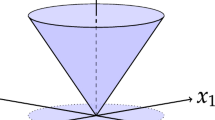Abstract
We focus on the convex semi-infinite program with second-order cone constraints (for short, SOCCSIP), which has wide applications such as filter design, robust optimization, and so on. For solving the SOCCSIP, we propose an explicit exchange method, and prove that the algorithm terminates in a finite number of iterations. In the convergence analysis, we do not need to use the special structure of second-order cone (SOC) when the objective or constraint function is strictly convex. However, if both of them are non-strictly convex and constraint function is affine or quadratic, then we have to utilize the SOC complementarity conditions and the spectral factorization techniques associated with Euclidean Jordan algebra. We also show that the obtained output is an approximate optimum of SOCCSIP. We report some numerical results involving the application to the robust optimization in the classical convex semi-infinite program.
Similar content being viewed by others
Explore related subjects
Discover the latest articles and news from researchers in related subjects, suggested using machine learning.Notes
Function f and cone \(\mathcal{K}\) are convex. Moreover, the KKT condisions of the problem “min f(x) s.t. \(x\in \mathcal{K}\)” can be written as \(x\in \mathcal{K}\), \(\nabla f(x)\in \mathcal{K}\) and \(x^{\top }\nabla f(x)=0\).
Assumption A (iii) and Proposition 4.1 yield \(0<-c({\overline{x}},\overline{s}_{\max })\le c({x^k},s^k)-c({\overline{x}},s^k)\le \nabla _{x}c({x^k},s^k)^\top ({x^k}-{\overline{x}})\le \Vert \nabla _{x}c({x^k},s^k)\Vert (M+\Vert {\overline{x}}\Vert )\), where \(\overline{s}_{\max }:={\mathrm{argmax}}_{s\in \Omega }c({\overline{x}},s)\). Therefore, we can choose \(\gamma :=-c({\overline{x}},\overline{s}_{\max })/(M+\Vert {\overline{x}}\Vert )>0\).
When \(\mathcal{I}^{k}_2=\emptyset \), we immediately obtain the desired result \(\mathcal{I}^{k}_2\subseteq \mathcal{I}^{k+1}_2\).
When \(\Omega =[l_s,u_s]\subset \mathbb {R}\), we test the 101 points \(l_s+i(u_s-l_s)/100\) with \(i=0,1,\ldots ,100\). When \(\Omega =[l_s,u_s]^2\subset \mathbb {R}^2\), we test the 121 points \((l_s+i(u_s-l_s)/10,\,l_s+j(u_s-l_s)/10)^\top \) with \(i=0,1,\ldots ,10\) and \(j=0,1,\ldots ,10\).
For Problem 7, the final active index is located in the interior of \(\Omega \), and for other six problems (5, 6, 8, 10, 11, 12), they are located on the non-vertex boundary.
For example, when \(\mathcal{K}=(\mathcal{K}^{\ell })^{m}\), we have m subvectors \(x^*_1,\ldots ,x^*_{m}\in \mathbb {R}^{\ell }\) for the optimum \(x^*\). Therefore, if the obtained solutions of the 100 problems are \(x^{*,1},x^{*,2},\ldots ,x^{*,100}\), then we have \(\lambda _i^{\max }:=\max \big \{\lambda _i(x^{*,p}_j)\bigm |(j,p)\in \{1,2,\ldots ,m\}\times \{1,2,\ldots ,100\}\big \}\) and \(\lambda _i^{\min }:=\min \big \{\lambda _i(x^{*,p}_j)\bigm |(j,p)\in \{1,2,\ldots ,m\}\times \{1,2,\ldots ,100\}\big \}\) for each \(i=1,2\).
References
Auslender, A., Goberna, M.A., López, M.A.: Penalty and smoothing methods for convex semi-infinite programming. Math. Oper. Res. 34, 303–319 (2009)
Ben-Tal, A., El Ghaoui, L., Nemirovski, A.: Robust Optimization. Princeton University Press, Princeton (2009)
Ben-Tal, A., Nemirovski, A.: Robust convex optimization. Math. Oper. Res 23, 769–805 (1998)
Ben-Tal, A., Nemirovski, A.: Robust solutions of uncertain linear programs. Oper. Res. Lett. 25, 1–13 (1999)
Bertsekas, D.P., Nedić, A., Ozdaglar, A.E.: Convex Analysis and Optimization. Athena Scientific, Belmont (2003)
Bonnans, J.F., Ramírez, H.: Perturbation analysis of second-order cone programming problems. Math. Progr. 104, 205–227 (2005)
Bonnans, J.F., Shapiro, A.: Perturbation analysis of optimization problems. Springer, New York (2000)
Chen, X.D., Sun, D., Sun, J.: Complementarity functions and numerical experiments for second-order-cone complementarity problems. Comput. Optim. Appl. 25, 39–56 (2003)
Faraut, J., Korányi, A.: Analysis on Symmetric Cones. Clarendon Press, New York (1994)
Fukushima, M., Luo, Z.-Q., Tseng, P.: Smoothing functions for second-order cone complementarity problems. SIAM J. Optim. 12, 436–460 (2001)
Goberna, M.A., López, M.A.: Linear semi-infinite programming: an updated survey. Eur. J. Oper. Res. 143, 390–405 (2002)
Gonzaga, C., Polak, E., Trahan, R.: An improved algorithm for optimization problems with functional inequality constraints. IEEE Trans. Autom. Control 25, 49–54 (1980)
Hayashi, S., Wu, S.-Y.: An explicit algorithm for linear semi-infinite programming problem with second-order cone constraints. SIAM J. Optim. 20, 1527–1546 (2009)
Hayashi, S., Yamaguchi, T., Yamashita, N., Fukushima, M.: A matrix splitting method for symmetric affine second-order cone complementarity problems. J. Comput. Appl. Math. 175, 335–353 (2005)
Hayashi, S., Yamashita, N., Fukushima, M.: A combined smoothing and regularization method for monotone second-order cone complementarity problems. SIAM J. Optim. 15, 593–615 (2005)
Hettich, R., Kortanek, K.O.: Semi-infinite programming: theory, methods, and applications. SIAM Rev. 35, 380–429 (1993)
Kato, H., Fukushima, M.: An SQP-type algorithm for nonlinear second-order cone programs. Optim. Lett. 1, 129–144 (2007)
Kortanek, K., No, H.: A central cutting plane algorithm for convex semi-infinite programming problems. SIAM J. Optim 3, 901–918 (1993)
Lai, H.C., Wu, S.-Y.: On linear semi-infinite programming problems: an algorithm. Numer. Funct. Anal. Optim. 13, 287–304 (1992)
Li, D., Qi, L., Tam, J., Wu, S.-Y.: A smoothing newton method for semi-infinite programming. J. Glob. Optim. 30, 169–194 (2004)
Lin, C.-J., Fang, S.-C., Wu, S.-Y.: An unconstrained convex programming approach to linear semi-infinite programming. SIAM J. Optim. 8, 443–456 (1998)
Lobo, M.S., Vandenberghe, L., Boyd, S., Lebret, H.: Applications of second-order cone programming. Linear Algebra Appl. 284, 193–228 (1998)
López, M., Still, G.: Semi-infinite programming. Eur. J. Oper. Res. 180, 491–518 (2007)
Narushima, Y., Sagara, N., Ogasawara, H.: A smoothing Newton method with Fischer-Burmeister function for second-order cone complementarity problems. J. Optim. Theory Appl. 149, 79–101 (2011)
Okuno, T., Hayashi, S., Fukushima, M.: A regularized explicit exchange method for semi-infinite programs with an infinite number of conic constraints. SIAM J. Optim. 22, 1009–1028 (2012)
Özmen, A., Weber, G.-W., Batmazb, I., Kropat, E.: RCMARS: robustification of CMARS with different scenarios under polyhedral uncertainty set. Commun. Nonlinear Sci. Numer. Simul. 16, 4780–4787 (2011)
Qi, L., Wu, S.-Y., Zhou, G.: Semismooth newton for solving semi-infinite programming problems. J. Glob. Optim. 27, 215–232 (2003)
Reemtsen, R., Görner, S.: Numerical methods for semi-infinite programming: a survey. In: Reemtsen, R., Rückmann, J. (eds.) Semi-Infinite Programming, pp. 195–275. Kluwer Academic Publishers, Boston (1998)
Reemtsen, R., Rückmann, J.: Semi-Infinite Programming. Kluwer Academic Publishers, Boston (1998)
Stein, O., Still, G.: Solving semi-infinite optimization problems with interior point techniques. SIAM J. Control Optim. 42, 769–788 (2003)
Still, G.: Discretization in semi-infinite programming: the rate of convergence. Math. Progr. 91, 53–69 (2001)
Wu, S.-Y., Fang, S.-C.: Solving convex programs with infinitely linear constraints by a relaxed cutting plane method. Comput. Math. Appl. 38, 23–33 (1999)
Wu, S.-Y., Li, D.H., Qi, L., Zhou, G.: An iterative method for solving KKT system of the semi-infinite programming. Optim. Methods Softw. 20, 629–643 (2005)
Yamashita, H., Yabe, H.: A primal-dual interior point method for nonlinear optimization over second-order cones. Optim. Methods Softw. 24, 407–426 (2009)
Yuan, Y.X.: Recent advances in numerical methods for nonlinear equations and nonlinear least squares. Numer. Algebra Control Optim. 1, 15–34 (2011)
Yuan, Y.X.: A trust region algorithm for Nash equilibrium problems. Pac. J. Optim. 7, 125–138 (2011)
Zhang, L., Wu, S.-Y., López, M.A.: A new exchange method for convex semi-infinite programming. SIAM J. Optim. 20, 2959–2977 (2010)
Author information
Authors and Affiliations
Corresponding author
Additional information
This research was supported in part by JSPS KAKENHI Grant Number 26330022, and by National Center for Theoretical Sciences, Taiwan.
Rights and permissions
About this article
Cite this article
Hayashi, S., Wu, SY. & Zhang, L. Computation Algorithm for Convex Semi-infinite Program with Second-Order Cones: Special Analyses for Affine and Quadratic Case. J Sci Comput 68, 573–595 (2016). https://doi.org/10.1007/s10915-015-0149-6
Received:
Revised:
Accepted:
Published:
Issue Date:
DOI: https://doi.org/10.1007/s10915-015-0149-6




